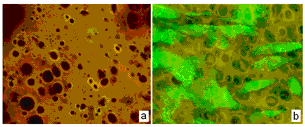431d Biomimetic Osteoinductive in Situ Crosslinkable Poly(Lactide) for Bone Regeneration
Methods: The amino acid sequence glycine-arginine-glycine-aspartate with an acrylate group at the glycine end (hereafter designated "Ac-RGD peptide") was synthesized in the solid phase with Fmoc- and Mtt- protected amino acid derivatives. To attach the RGD peptide to the scaffold, an unsaturated acrylate group was linked to the peptide at the arginine end using a glycine linker. The product was purified by preparative HPLC and characterized by Electro Spray Ionization spectrometry (ESI-MS). Reactive poly(lactide) macromer was synthesized by condensation polymerization of ULMW PLA with FC. ULMW PLA was synthesized by ring-opening polymerization of the lactide monomer. The chemical structure and molecular weight distribution of the synthesized polymers were characterized by 1H-NMR, FTIR, and GPC. The porogen leaching technique was used to fabricate porous scaffolds using in situ crosslinkable RPLA macromer, Ac-RGD peptide crosslinker, and porogen (NaCl crystals with an average size of 300ƒÝm). Sterile disk-shaped scaffolds (12x2 mm) were inserted into transwells and the edges were coated with a silicone sealant. The exposed area of each disk was seeded with 100 ƒÝl of the BMS cell suspension at a density of 1x107 cells/ml and incubated in complete osteogenic media without BMP for 7 days. Disks were rinsed in PBS and stained with fluorescent dyes calcein AM and ethidium homodimer-1 for visualization of the live and dead cells, respectively. A confocal fluorescent microscope (Zeiss LSM-510 META Axiovert, Carl Zeiss) was utilized to take depth projection images perpendicular to the plane of the microscope.
Results: A 45 ƒÝm thick section near the scaffold surface for low (1x10-4 M; a) and high (1x 10-2 M; b) Ac-RGD peptide concentrations was imaged with confocal microscope. The images (see the following figure) clearly demonstrates that cell attachment depended on the Ac-RGD concentration. Focal point attachment of the BMS cells to the RPLA scaffold with high RGD concentration was observed. The distribution of live BMS cells migrated into the scaffold was imaged with a confocal microscope. Migrating cells showed extended morphology inside the scaffold when RGD peptide linker was used.
Conclusions: Biomimetic in situ crosslinkable poly(lactide) scaffolds as a carrier for BMP support attachment and migration of bone marrow stromal cells.
